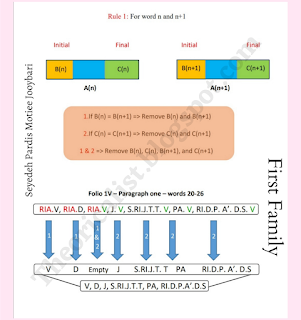The Concept of Immortality in the Voynich Manuscript
The writings next to the figures can form a line. A line that could be decoded like the paragraphs.
Folio 99 R
 |
| Recreation of plant figures of the folio 99r in Voynich manuscript |
As you can see the word "Amrita" appears which has roots in ancient Persian and Sanskrit languages. Amrita is a Sanskrit term which in Persian it is the Amertat or Amerdad = Immortality
 |
| Removing repetitions for writings around the plant figures of the folio 99r of Voynich manuscript creates the word amrita. |
I have tried reading the first and second paragraph of this page and the meanings suggested cooking plant structures separately and some sort of recepie for becoming immortal.
 |
| f99r-p1 |
f99r- paragraph1-line1:
A) Voynich manuscript:
Baad basaa nabaat va pajad saghat
باد بسا نبات و پجد ساقات
B) Older Persian:
Baad basaa nabaat va pazad saghat
باد بسا نبات و پزد ساقة
C) Modern Persian:
Bashad besyaar gyiah va mipazad sagheh
باشد بسیار گیاه و می پزد ساقه
Definition:
There are many plants and the stem cooks.
Or
There are many plants and (he/she) cooks the stem(s).
 |
| f99r-p2 |
f98r-paragraph2-line1:
A) Voynich manuscript:
Rishaa nabaat ke darish bapajad
ریشا نبات ک دریش باپجد
B) Older Persian:
Risheh nabaat ke darish bepazad
ریشه نبات که دریش بپزد
C) Modern Persian:
Rishe giyah ke dar aan bepazad
ریشه گیاه که در آن بپزد
Definition:
Root of plant that it cooks in that.
Or
Root of plant that (he/she) cooks in that.
By "Older Persian" I don't mean Ancient Persian or Avestan , but maybe a few centuries older than Today's Persian which can be found in literary works.
By "Modern Persian" I mean the form that is easily understandable for Farsi speakers, with help of nowadays vocabulary.
[Procedure includes irregular removal of D in first and second words after observation of M.P.A.T sequence.]
S.P Motiee Jooybari
29 May, 2024



Comments
Post a Comment